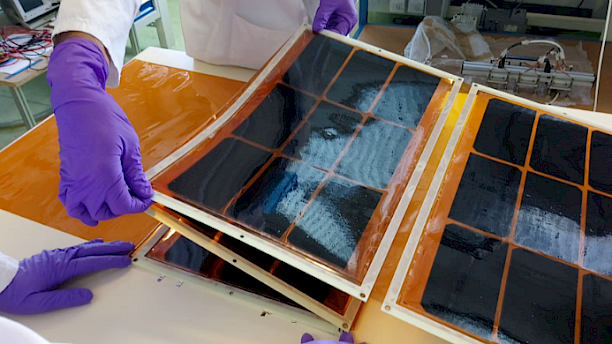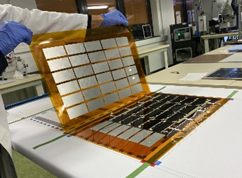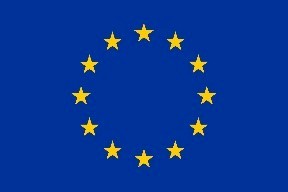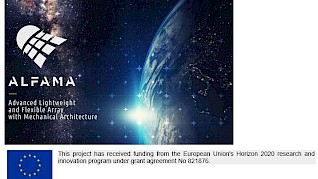The CEA at INES has produced the first large, flexible and foldable solar sails for space generators in the framework of the European ALFAMA project.

Solar sails for space activities
The space industry is facing a wave of major changes and an increase in space activities, which is associated with an increased need for photovoltaic energy for geostationary orbits.
Space missions increasingly require power supplies above 25 kW for solar electric propulsion or high-throughput satellites. The power requirements are therefore growing in Watt/kg, Watt/m² and Watt/m3. The space launcher volume remains limited and restricts the number and size of rigid solar arrays that can be carried on board. The answer to this constraint lies neither in stacking more of the existing rigid solar arrays nor in marginal solar cell efficiency improvements, but rather with innovative solutions such as thin and flexible photovoltaic arrays (PVAs).
Conventional space PVAs are made with a thick, rigid architecture, using a honeycomb aluminium substrate, on top of which cells are bonded, with individual coverglass protection. These PVAs are generally thicker than 20 mm, which limits their performance in Watt/kg and Watt/m3. This limitation can be overcome by switching to thin, flexible PVAs.

Thirty years ago, the European Space Agency (ESA) developed the first flexible PVAs for the Hubble Space Telescope. Today, this approach is being actively pursued in the United States, with, for example, Ultraflex PVAs on Orbital ATK's Cygnus spacecraft in 2011 or ROSA (Roll-Out Solar Array Experiment), installed on the International Space Station in 2021.
The H2020 ALFAMA project is developing a European flexible PVA solution.
The work carried out by the CEA at INES, in this framework, focuses on the design and manufacture of thin and flexible PVA architecture, dedicated to vibration and deployment tests.
The constraints of the space environment impose selection of appropriate materials to design a robust architecture. The materials must resist vacuum, thermal cycling and irradiation. Several designs were investigated in the project with different masses and thicknesses. As the project also aims to use innovative and low-cost processes from the terrestrial photovoltaic industry, our researchers have developed a lamination process for the several concepts studied.
The CEA at INES has just completed two large-scale demonstrators of solar sails (foldable large-area space photovoltaic panels), from design to manufacture, i.e. a TRL increase from concept to level 4.


These demonstrators use the basis of proven, low-cost processes from the terrestrial photovoltaic industry, such as large-area lamination, and their extreme thinness (< 1 mm) enables higher specific power targets.
The first large solar array with a surface area of 3.7 m², thin and foldable, was made to perform a vibration test that simulates the environment of a space launch vehicle. It passed this vibration test at the ESTEC (European Space Technology Centre) facilities.
A second, larger demonstrator, with a surface area of more than 5m², has been manufactured to validate the foldable function of the concept through a deployment test (yet to come). Visual inspection and electroluminescence imaging confirm the mechanical and electrical integrity of these large innovative coupons.
In the coming months, the four large sails of the second demonstrator are scheduled to be coupled with the telescopic mechanism developed by ADS NL, thus completing the deployment test.
Future work will then focus on improving the reliability of the design and manufacturing processes, adapting them for future generations of ultrathin cells, as well as on ageing tests of these PVAs in representative environments on Earth and in space.
This project have received funding from the European Union's Horizon 2020 research and innovation program under grant agreement No 821876.

See our July 2020 news on the ALFAMA project
The ALFAMA project - Advanced Lightweight and Flexible Array with Mechanical Architecture - provides innovative solutions by developing thin, foldable solar panels with low-cost manufacturing processes such as lamination and printed electronics.
